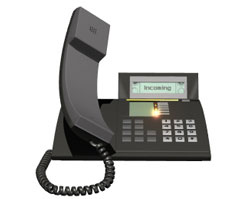 The answer may well be SIP over MPLS. You may already have an MPLS network in place for sharing data files between branch offices and headquarters. Cost tradeoffs almost always give the advantage to an MPLS network over a suite of point to point data lines of equivalent bandwidth. With MPLS, you only need a last mile connection to each of your locations. As the name implies, these are point to point pipes measuring just thousands of feet to the nearest central office. The major distance spans are handled by the fiber optic core of the MPLS network.
The answer may well be SIP over MPLS. You may already have an MPLS network in place for sharing data files between branch offices and headquarters. Cost tradeoffs almost always give the advantage to an MPLS network over a suite of point to point data lines of equivalent bandwidth. With MPLS, you only need a last mile connection to each of your locations. As the name implies, these are point to point pipes measuring just thousands of feet to the nearest central office. The major distance spans are handled by the fiber optic core of the MPLS network.There are also security advantages with MPLS versus IP networking, such as the Internet. MPLS uses proprietary labels to direct traffic, not the IP header information that is often the target of malicious activity. The network is privately operated and not accessible by the general public. You need to be a contracted customer with defined locations and connections between them that are managed by the network operator.
What you may not realize is that MPLS networks can handle voice traffic as well as data. The name MPLS actually stands for Multi-Protocol Label Switching. The network can handle nearly any protocol and is perfect for packet switched services of all types. For larger organizations, MPLS provides the WAN connections you need to link a few or many converged voice and data networks.
Do you currently have data connections between your sites but stand-alone analog or PRI telephone lines at each? That works, but you are probably paying toll charges to call between offices. There’s no economy of scale if each facility is relatively small and in a different city or state than the others. By consolidating your telephony, data lines and perhaps broadband connectivity with a single provider you can likely realize a considerable cost savings while maintaining call quality and network speed.
The MPLS labels or tags do their magic by not only specifying packet destinations, but also class of service. This keeps data file transfers from damaging the much more fragile real-time demands of voice and video. If you have company wide VoIP now and conversations get distorted or calls drop when the network gets congested, traffic engineering is what you need. MPLS networks are engineered with committed rates for your services, as well as those of other network customers. That ensures that you have the bandwidth you purchase regardless of what anyone else is doing. Contrast that commitment with the best-effort information services, such as the Internet, where performance is all over the map.
With SIP over MPLS, your telephone calls within the company stay on-net and off the public switched telephone network. You don’t pay toll charges for office calls that stay on your network regardless of whether they are from desks twenty feet apart or branch offices thousands of miles apart. It’s even possible to include international locations on the same MPLS network to truly integrate your company communications. When calls go off-net to outside landlines or mobile phones, those terminations are handled by your SIP Trunking service provider. Since the network is converged, there is no need for a separate telephone network and your support needs may also be reduced.
Does your organization have multiple locations that could be more efficiently run by a voice and data MPLS network? Get pricing for MPLS Network Services quickly and easily to compare with your current bills.


No comments:
Post a Comment